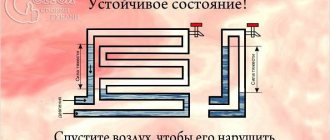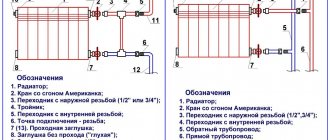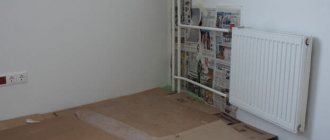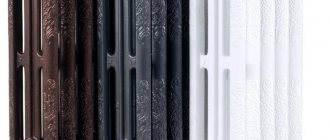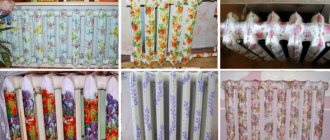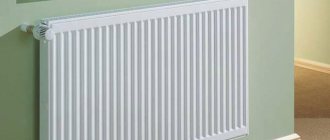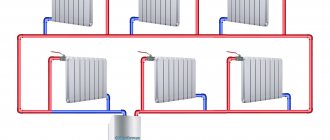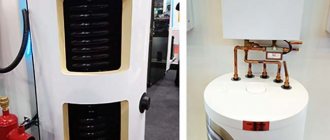Requirements for paintwork
To paint cast iron batteries with your own hands, choose paintwork materials that meet the following criteria:
- resistance to high temperatures, the permissible minimum is +80°C, but it is better if the composition can withstand values up to +100°C;
- good adhesion - it allows the applied layer to remain on the surface of the radiators for a long time, even when used in difficult conditions;
- resistance to mechanical stress: batteries are often located in areas with high traffic, it is important that the finish retains its properties even when applying a thin layer;
- non-susceptibility to corrosion: when the composition is applied over metal, the likelihood of rusting should be reduced;
- ability to maintain color under the influence of temperature changes;
- safe composition: substances containing toxic components should not be used for finishing central heating devices, since when heated they will be released into the air, worsening the health of residents;
- choose odorless paint, since finishing work is carried out inside the living space.
Painting the battery outside the heating season
Preparation
The first step is removing the old paint. Due to the fact that the design of the battery makes many of its places difficult to reach, it is not possible to clean it the old-fashioned way using a metal brush.
A soldering iron or hot air gun will not work. Since in the first case the structure can be damaged, and in the second it is simply useless.
The best way to clean a battery from old paint is a variety of chemical removers.
Paint remover can remove paint even in hard-to-reach places
Of course, this method also has its drawbacks, but it still gives the best results. The remover works on the principle of a solvent. It penetrates the paint layer, softens it and then scrapes off the old paint quite easily with a putty knife or metal scraper. Among other things, the remover does not damage metal or wood, so it can be used before painting the batteries.
When working with the substance, hold the bottle with the neck away from you so as not to accidentally inhale aggressive vapors of the liquid. The room must be well ventilated.
How to paint batteries:
The process of painting radiators
- apply wash;
- remove old paint;
- rust must be sanded off;
- treat the battery with a degreaser (white spirit or slightly alkaline solution);
- if necessary, apply a primer;
- After drying, you can apply the main color.
Recommendations on how to paint cast iron batteries with your own hands
- Batteries should only be painted when they are cold . Therefore, it is better to postpone all work to a time when the heating season has already ended. If the need arises in the autumn-winter season, turn off the valves and wait until it cools completely.
- If you have to apply paint to warm radiators, use a spray can or apply a very thin layer. The whole difficulty of applying paint to a hot surface is that brush marks remain. In addition, the paint may change color and the batteries will become stained.
- Radiators can only be connected after the paint has completely dried.
Interesting colored batteries will become a highlight of the kitchen
The room must be ventilated. If this is not possible, use a respirator.
How to choose the right paint for heating radiators:
Alkyd enamels
Positive traits:
- resistance to high temperatures;
- wear resistance, due to which the neat appearance of the batteries is maintained for a long period.
Such properties make it possible to paint heating radiators. Alkyd enamel protects devices from rust, increasing their service life. When applied, it lays flat, so no adjustments are required to the coating. There are a large number of shades of alkyd enamel, so you can always choose the right tone to suit your interior.
Alkyd enamels for painting heating radiators.
Alkyd enamel is stronger than most analogues. Its disadvantage is the release of toxic fumes, the reason lies in the solvent content in the composition.
The smell is strong, dissipates slowly - 1 day after painting. During this time, you need to leave your home, and the room should be ventilated. Sometimes the smell is faint even after drying.
When looking for an answer to the question of how to paint a heating radiator at home, pay attention to the ability of paintwork materials to maintain the original tone.
Alkyd enamel quickly loses its shade and turns yellow, although it continues to retain its strength and other properties. The yellowness is more pronounced if the color chosen is white. When purchasing alkyd enamel, it is better to consider darker tones with a glossy sheen.
Please note: Painting doors: choosing a paint material, step-by-step instructions for painting, how to choose a color
Types of compositions
In order for painted RO to retain its visual appeal for as long as possible and give maximum heat to the room, when choosing a RO, you need to carefully study its technical and aesthetic properties.
Pros of acrylic PS
Acrylic PS is highly praised. Its undeniable advantages:
- absence of harmful substances;
- no smell;
- does not pose a danger to humans.
At +23 degrees, acrylic PS dries in just half an hour. It is not afraid of moisture and creates a durable layer that is resistant to various mechanical damage.
Acrylic paint tolerates heat well and does not lose all its positive properties for about eight years.
During the entire period of operation, the RO will not appear yellow, cracks or chips. The whiteness coefficient of acrylic PS is 96 percent. The paint on the batteries looks good and looks like glossy plastic.
Acrylic PS
Specifics of alkyd PS
Alkyd PS is resistant to high heat, so it can also be used to paint batteries. It is more durable than acrylic, has an anti-corrosion effect, is easy to apply, and gives a smooth finish.
But alkyd PSs are not as safe as water-based emulsions. They contain a solvent, so they have an unpleasant odor that can be felt for several days after painting with RO.
Alkyd PS takes a very long time to dry and all this time a strong aroma is felt in the room. Experts recommend using it only in well-ventilated rooms. It is ideal not to live in the house at all while the paint is drying.
Another important disadvantage of this paint is the rapid loss of color and the formation of a yellowish tint. To slightly delay this unpleasant moment, choose alkyd mixtures with a glossy effect.
Alkydnaya PS
Other types of PS for RO
If you plan to paint a heating radiator over old paint, you can use mixtures with aluminum and silicate resins. They will create a dense elastic layer on the RO that will not crack even due to strong heating.
The silicate mixture has good adhesion, so you don’t have to prime the surface first. It is suitable for working at very high temperatures. The only negative is the persistent unpleasant odor.
It is worth mentioning hammer paint - this is a type of alkyd. It gives an interesting specific coverage. After painting, the surface seemed to have been beaten with a hammer. This effect formed the basis of the name.
The undeniable advantage of hammer PS is that it can hide numerous external defects of the RO. This is especially important if you don’t know how to paint a cast iron battery to hide its rough surface.
RO is often painted with silver, which is created by mixing varnish and aluminum powder. The paint tolerates heat well and is easily applied over primer and old PS. But it has a very strong unpleasant aroma, so after painting with RO the room needs to be well ventilated.
Important! Aluminum powder is explosive. Cooking silverfish at home is risky. You should not do this if there are flammable objects and children in the house.
Acrylic enamels
These enamels are included in the group of water-based compositions. They are conditionally safe for humans and do not emit an unpleasant odor. This allows them to be used for painting items used indoors.
Acrylic paint for painting heating radiators.
After application, they dry relatively quickly; after half an hour, the applied layer sets and stops sticking, so there is no need to leave your home for 1-2 days. High drying speed is ensured provided that suitable conditions are created: the air temperature is within the range of +18...+23°C.
High strength and anti-corrosion resistance are due to the ability of acrylic enamel to repel moisture. Such enamel does not deform when exposed to mechanical load, the average service life is 7-8 years.
During the entire service period, it is resistant to temperature changes, and the appearance of the coating does not deteriorate. For water-based metal paints, no less important is the ability to retain the original color, so they do not turn yellow during use.
Implementation
Stages of radiator restoration.
Dismantling
Do-it-yourself dismantling of a radiator begins with dumping the risers: cast iron radiators were extremely rarely equipped with shut-off valves on the connections.
In addition: the service life of screw valves in cast iron bodies, which were in use 30 years ago, does not exceed 10 - 15 years. The chances that they remain operational are minimal.
The discharge of risers is also carried out in a strictly defined order.
To drain the riser in a bottom-fill house (that is, a house in which both the supply and return heating pipelines are located in the basement), you must:
- Based on the entrances (their lower flights extend into the basement), find the heating riser to which the required heating device is connected;
- Close the valve on it;
- Block two adjacent risers - on the right and on the left;
- Partially unscrew the plug on the riser and wait for the pressure on it to drop;
The task will be greatly simplified if the risers are equipped with vents.
- Open the valves on adjacent risers one by one to reveal the steam one to yours;
- Fully open the valve, manipulation of which did not cause an increase in the pressure of the stream from under the plug on your riser;
- Completely close the valve on the other riser;
- Unscrew the plugs to release the paired risers.
To dismantle a cast iron battery you need:
- Fit the locknuts along the threads on the liner until they end;
Note! If layers of paint prevent you from unscrewing the locknut, first burn off the paint on the thread with a hair dryer, blowtorch or gas torch.
If the connection to your radiator looks the same, thread annealing is required.
- Fit the radiator plugs after the nuts. They are unscrewed with gas keys No. 2 - No. 4. If the plug does not come out of place, do not apply excessive force, but heat it with the same hairdryer or burner, after which the thread will come out much easier;
- Remove the battery from the brackets;
- Having laid it on the floor, unscrew the blind plugs. Don't forget: they have left-handed threads that need to be unscrewed clockwise.
Straight-through and blind plugs have counter-directional threads.
Annealing
The most convenient way to anneal several multi-section radiators at once is in a fire: a hairdryer, burner or blowtorch will stretch the heating of all sections to a cherry glow for tens of hours.
The annealing instructions are extremely simple:
- The batteries are folded like a house;
- A fire is lit in the center of the house. The flame is maintained for at least 1.5 - 2 hours: all sections and, most importantly, their contents must be heated to 700 - 800 degrees;
- The radiators then cool naturally for 2 to 4 hours. Under no circumstances should they be placed in the snow or watered with water: a sharp temperature change can lead to cracks.
Cleaning
After heating, the sludge deposits in the channels and collectors of the sections are completely destroyed; however, their remains must be removed from the radiators. For this:
- The battery is disassembled into separate sections using a radiator wrench. After annealing, this operation requires minimal effort: there is no need to worry about stuck nipples;
- Then each section is tapped with a wooden mallet in a vertical position. The sand and rust pouring out of it are the remnants of the silt that previously clogged it.
During the heating process, the old paint burns out completely, leaving only a thin layer of soot on the surface of the cast iron. Since painting batteries - cast iron or any other - requires cleaning the base, we clean the surface with a regular wire brush. Cleaning each section takes no more than two to three minutes.
The remains of the old coating are cleaned with a wire brush.
Bulkhead
Now we need to reassemble the sections into the heating device. Since the old gaskets are burnt out, they need to be replaced.
The price of a new paronite gasket for a cast iron battery is more than low - from 1.3 rubles per piece.
Paronite intersection gaskets.
However, instead of hard paronite, which requires a lot of force for compression, it is better to use homemade gaskets cut from an old car inner tube.
They are cut with ordinary scissors:
- The chamber is cut along the circumference, turning into a flat strip;
- The nipple is applied to a sheet of rubber and outlined with a pen;
- Then the middle of the future gasket is cut out with scissors with sharp blade tips;
- Finally, the gasket is cut in a circle. The width of its rim should be approximately 10 millimeters: when the sections are pulled together, the rubber is flattened, and if the gasket is made wider, its edges will protrude beyond the sections.
After installing the gaskets, the nipples are tightened one by one, one turn at a time. It is important to avoid distortions, which can lead to jamming of the thread or even rupture of the nipple.
Radiator bulkhead diagram.
Primer
How to properly paint cast iron batteries, ensuring maximum adhesion of the paint to the base? Obviously, you should start with a primer. Manufacturers of cast iron radiators supply them with a coating of anti-corrosion primer GF-021; for us it will also be the best choice.
Anti-corrosion glypthal primer GF-021.
The primer is diluted to a working viscosity corresponding to the consistency of full-fat milk with a solvent and applied with a regular brush in one layer. Drying time at room temperature ranges from 30 minutes to an hour.
Attention: GF-021 is positioned by GOST 25129-82 as a slightly toxic material. All work with it is carried out in a ventilated area; The use of a respirator is strongly recommended.
The primer is applied in as thin a layer as possible; drips are immediately picked up with a brush. Dried unevenness of the primer is removed with fine sandpaper, after which the area is primed again.
Painting
How to paint cast iron batteries to obtain maximum color stability?
Any paint that contains the word “heat-resistant” in its description. Here are some examples.
| Name | Short description | Price |
| Dufa Aqua-Heizkorperlack | Water | 435 rubles/0.75 l |
| Tex Pro for radiators | Pentaphthalic, diluted with white spirit | 300 rubles/0.55 l |
| Tikkurila Termal | Water-based silicone | 640 rubles/0.33 l |
Silicone Tikkurila Thermal.
Note! Glossy paints highlight all surface defects. Matte ones hide them, but tend to actively collect dirt due to the rough surface.
How to paint cast iron batteries without drips? The paint, diluted to the already familiar consistency of fatty milk, is applied in two or three as thin layers as possible, with intermediate drying.
The tool is a brush with medium bristles and the most durable sleeve. If you hold the lint and pull the handle and pull out a few hairs, it means that they will remain on the painted surface.
It is better to apply paint to the front surfaces of the sections by laying the battery horizontally - this will reduce drips. The back surface is painted similarly; For obvious reasons, the radiator turns over only after it has completely dried.
After each layer has dried, the radiator is inspected for drips; all detected defects are immediately cleaned with fine sandpaper. The last layer is not sanded.
As a result, we should get a uniform coating without gaps or drips.
Don’t forget: before painting, you should place thick polyethylene under the battery. No matter how careful you are, a few drops of paint will inevitably end up on the floor.
A special case
In industrial conditions, special requirements may be put forward for the coatings of heating devices, which, accordingly, require the use of special materials.
Here are some examples of exotic paints that are rarely used in everyday life.
- Zinga conductive paint is a dispersion of zinc powder in a weather-resistant varnish. After drying, it provides the most durable and strong anti-corrosion protection that can withstand prolonged contact with aggressive environments;
The photo shows packaging of Belgian-made Zinga paint.
- Fire-retardant paints for metal Polistil swell when heated and form a thick coating on the painted surface with low thermal conductivity and fire resistance for up to 90 minutes;
- Certa anti-corrosion paint can withstand heating up to 900 degrees without changing color or other characteristics. It can be used for painting steam heating radiators, steam lines and engine parts.
Dispersion acrylic paint
Advantages:
- high drying speed, thanks to this you can use the room during repairs;
- no odor;
- The material is applied easily, resulting in a uniform layer.
It can withstand high temperatures, which is why it is often used for painting radiators, and during operation the coating does not crack, which allows it to be renewed less often.
There are 2 types of dispersion acrylic paint on sale:
- matte;
- glossy.
Materials of this group are applied in several layers, their quantity depends on the quality of the rough base. The pre-priming method is popular, for which dispersion acrylic paint diluted with water is used. This measure improves adhesion.
Silicone paints
Silicone paints for heating radiators.
Contains polymer components (silicone). To obtain the desired consistency, add an aqueous or organic solvent.
Advantages:
- resistance to high temperatures;
- moderate elasticity of the finished coating, which eliminates the risk of cracking under the influence of temperature changes;
- it is not necessary to prepare the surface of heating devices;
- resistance to loads, the risk of abrasion during operation is reduced, which increases service life;
- good tolerance to ultraviolet radiation, due to which the original shade is preserved.
Silicone paint is more expensive than analogues, but lasts longer.
Choosing the Right Paint
When choosing paint for heating radiators, you should take into account several requirements that the product must meet:
- Heat resistance . Since batteries are, in principle, a heating device, the paint must be heat-resistant. Keep this in mind when choosing paint that is resistant to high temperatures.
- Non-toxic . When heated, paint can emit an unpleasant odor as well as toxic substances that can cause allergies, headaches and even poisoning.
- The shine of the paint is provided by acrylic , but it is worth remembering that when painting the room there will be a rather pungent odor. An unpleasant odor may not disappear for quite a long time - the room must be ventilated for several days. Follow safety precautions when working with paint
It is worth noting that acrylic paints are among the most durable and resistant. In addition, acrylic paint is wear-resistant and not subject to abrasion.
Other paint options for radiators
Hammer paints perfectly hide all the unevenness of cast iron radiators.
If for a number of reasons it is not possible to apply the options discussed above, you can choose one of the following:
- Paints containing silicate resin. When applied, a dense coating is created. The advantage is moderate elasticity, as a result of which the appearance of the finish is maintained throughout the entire service life of the heating device. The paint adheres well to the metal, and it is not necessary to prepare the surface before applying it. The disadvantage of silicate resin is its intense odor.
- Hammer paints. They belong to alkyd compositions, they help create a hammered effect, artificially age the surface (cracks appear on it), and allow you to obtain a coating of uneven thickness and structure.
- Based on aluminum powder. Another name is silverfish. Advantages: resistance to the influence of extreme temperature values, the ability to apply both to old batteries and to new ones after they have been prepared. The paint emits an intense odor, so you will need to leave the room after painting.
Pay attention to: Which façade paint to choose for exterior concrete work. Types, characteristics, how to use it correctly.
Paint for cast iron radiators
Cast iron heating radiators - veterans of heating systems
You are planning to renovate your home – you have a lot of plans, projects, ideas that you really want to bring to life. Walk around the apartment, assessing the scope of work, making notes - what to repair, what to replace, what to refuse in principle. The list of work is growing quickly, and the list of projected financial expenses is growing even faster. And then your gaze comes across the venerable “grandfather” in the living room - the good old cast-iron heating radiator. And you are thinking - should you keep it and restore it or throw it away and replace it with something more modern?
Do not rush to abandon these veteran heating systems - if handled correctly, they are quite capable of serving you for a long time and faithfully . Did you know that cast iron heating radiators were invented back in 1857 by the Frenchman Franz San Galli and since then have faithfully served to heat any type of room. There are good reasons for this, namely the following qualities:
- Excellent heat dissipation;
- High temperature inertia - that is, our batteries heat up for a long time, but also cool down for a very long time, leaving the room warm and heated for a long time;
- Low hydraulic resistance - the coolant, circulating inside the radiators, encounters almost no resistance and there is no need for forced circulation;
- Durability - just look at how many years these “dinosaurs” can serve without losing their qualities;
- Corrosion resistance – cast iron is slightly susceptible to corrosion, which significantly affects the durability of the product.
As you can see, there are a lot of advantages and it’s too early to write off old heating batteries in the trash. As for the unattractive appearance, the product can always be painted, this will certainly solve the problem.
Preparing heating radiators for painting
So, before painting, you need to properly prepare the surface of the battery. This is necessary so that the paint applies evenly and correctly, so that good adhesion to the surface is ensured, so that over time the coating does not chip off or fall off. So, let's look at the preparation process step by step:
- First, you need to thoroughly wipe the surface of the unit, completely removing dust, debris, and various types of dirt;
- As a rule, our “veterans” are covered with old paint in many layers and reliably to the point of fossilization - all this must be removed before painting. For this purpose, we use various types of chemical removers based on solvents and acids. We carefully read the instructions, apply the substance to the surface, wait for the time specified in the instructions and proceed to remove the “fossils”;
- Old paint softens under the influence of chemical removers and we can remove it using a spatula and special hard brushes. However, it must be remembered that removers do not work on paints produced before the middle of the last century, since they were made from natural ingredients;
- So, the old coating has been removed and you can proceed to the next stage - sanding the surface with sandpaper. We agree - the work is dreary, requiring remarkable patience, but absolutely necessary if we want to paint our battery with high quality;
- And at the end, the surface should be primed with a special primer so that the paint adheres well and holds tightly.
Choosing paint for radiators
Now is the time to ask yourself a legitimate and entirely appropriate question:
“What would be a better way to choose what paint to paint our battery with?”
There are a number of possible coating options for cast iron radiators, and which one to choose is up to you, of course.
Our coating must have the following properties:
- Heat resistance - that is, not destroyed under the influence of temperatures up to 80 degrees Celsius;
- Environmentally friendly - the coating should not have any negative effects on the human body;
- The coating must protect the surface of the unit from corrosion;
- The ability to retain its original color for a long time.
Let's look at what we can use to paint our battery.
- Alkyd enamel is quite durable, strong, and capable of maintaining the integrity of the structure for a long time. However, after application, a specific chemical smell lingers for a long time. Therefore, if you decide to paint the surface with this enamel, wear a respirator;
- Water-dispersed acrylic enamel - dries quickly, has no pungent odor, is durable and strong. The disadvantage is that for painting heating radiators you need to choose only special heat-resistant enamels;
- Acrylic enamel with solvent - does not require surface priming, is easy to apply, dries quickly, and does not have a strong chemical odor. However, there are difficulties with solvents and this paint cannot be shaded with the desired color.
You can cover the battery with regular oil paint, but this is unlikely to make the unit more attractive - oil paint is simply not intended for such purposes. And there is an opinion that heat transfer may suffer from this.
Be sure to pay attention to an important detail - batteries must be painted cold! When painting a heated surface, the paint applies unevenly, bubbles, and wrinkles. Therefore, all work of this kind should be carried out during the non-heating season.
Conclusion
So, as you have seen, you should not rush to get rid of old cast iron radiators. Being in good working order, if painted correctly, they can look attractive and will provide warmth to you and your home for a long time.
Procedure for preparing a battery for painting
The need for preparation is due to the following factors:
- ensuring uniform coverage;
- the need to eliminate defects;
- ensuring high adhesion.
Preparing the surface for painting increases the service life of the finishing material layer. Treatment is not carried out in all cases: metal and the use of some types of paints and varnishes do not require it.
In addition to aesthetic qualities, coloring also affects the heat transfer of heating devices. The preparatory stage includes removing old paint. If this is not done, over time the number of paint layers increases, and heat transfer is greatly reduced.
Methods for removing dust and grease
Removing dust and grease from the radiator.
You need to paint a surface that is free of dirt and grease deposits. When this step is skipped, the paint lays unevenly, adhesion decreases, and the appearance of the radiator deteriorates. You can remove layers of dust with a vacuum cleaner and rags.
Wet cleaning is more preferable because it removes dust particles better. Dry cleaning can cause contaminants to become airborne and then settle back onto the battery.
It is difficult to remove fat deposits without special products. It is recommended to use dishwashing liquid or stovetop liquid. To better clean the radiator, use a sponge with a rough surface. After cleaning, wipe the device with a damp cloth.
Mechanical removal of old coatings
Aggressive methods are used to remove rust and peeling paint. Mechanical cleaning is performed using a stiff metal brush. The manual method is recommended if the rust area is small. When it is necessary to clean the entire radiator of old paint, use an angle grinder with attachments (cleaning wheel); in hard-to-reach areas, an additional brush is used.
When using a grinder with an attachment, you should not apply much force, otherwise the top layer of metal will be removed. It is not recommended to completely remove the paint, just remove the peeling areas. When the surface becomes smooth, you can stop working, even if pockets of the old layer are still visible.
How to remove paint with chemicals
Chemical removal of previous paint.
If a suitable tool is not at hand, solvents are used. Such products are available in the form of gels, pastes, aerosols, and they treat the entire radiator. To use paste or gel, you need to prepare a brush with natural bristles.
When the entire surface of the battery is covered with the substance, the device is covered with film to enhance the effect. The duration of exposure depends on the type of product and ranges from 15 minutes to several hours. Do not keep the solvent on the radiator for longer.
The aerosol is sprayed over the battery, its exposure period is shorter than that of gel or paste - up to 60 minutes, depending on the type of product.
The advantage of the aerosol is that it can be used to treat hard-to-reach areas. After allowing enough time, the old paint is removed with a metal brush, an angle grinder with an attachment, or you can use a spatula, as the material softens.
Chemicals do not harm cast iron, however, during the production of batteries from this material, a seal is laid, which is susceptible to the influence of solvents. As a result, in winter, after starting the heating system, the appliances may leak.
Pay attention to: Choosing paint for children's furniture
When working with chemicals, you need to wear gloves, closed clothing and a respirator, as they are toxic.
Surface priming rules
After removing rust, old coating and dirt, they proceed to preparing the radiators for painting. To do this, use a primer composition intended for processing metal products. The material must be resistant to corrosion. After the primer has dried, painting begins.
The need to paint heating equipment
Heating appliances need to be painted in only two cases:
- if the old paint on cast iron batteries in use has lost its original color and peeled off;
- if the builders installed convectors in the house from the 90s of the last century, which are a coil of a heating riser with a few pressed-on fin plates.
If painting is required in the second case, then only the decorative screen and the flap swinging from above are subjected to it. There is only one way to paint the inside of a battery with fins between the plates - this is by completely immersing the convector in a container with a coloring composition. But narrowing the gap between them leads to a decrease in heat transfer from the equipment.
Heating devices of a more modern type should not be painted, especially for products with aluminum fins. If you do this, the heat transfer of such a radiator will decrease and its appearance will deteriorate. The fact is that layers of paint applied with a brush are unlikely to turn out perfectly smooth and the result will not be similar to a durable powder composition applied in a factory.
It is advisable to paint plate radiators and other heating devices that have a large frontal surface area made in the form of one panel on the floor in a horizontal position using a spray can or sprayer. As a result of using this method, the paint layer is almost perfect.
However, regardless of the choice of how to beautifully paint batteries, the product will not become better. To fit them into the color scheme of the renovated room, you can use a decorative screen for heating radiators.
Heating radiator painting
During the work process, mistakes are often made: a thick layer is applied, preparation is neglected. This leads to deterioration in the appearance of the device and shortens its service life.
A good example for painting a cast iron radiator.
General dyeing technology
You need to start work by applying a small amount of paint to the battery. If the coating is uneven, the process is repeated. All subsequent layers are applied after the previous one has dried. It is recommended to work with 2 brushes: one wide, the second small, but with a long handle, flexible enough to reach difficult areas inside the radiator.
It is necessary to remove loose fibers; to do this, the brush must be fluffed. Work starts from the internal surfaces and moves from top to bottom. When moving to the outer walls, paint is also applied first to the upper areas. Defects (smudges) formed during painting are removed with medium-grit sandpaper. These areas are painted over when the composition is reapplied.
The nuances of painting aluminum radiators
Defects on aluminum heating devices can be removed using automotive putty. The surface is first cleaned, degreased, and coated with a primer. When the putty is dry, begin painting.
Aluminum radiators are treated with an aerosol; auto enamel is often used for this purpose. It should be applied to hot radiators - this ensures quick drying. There is no need to remove the old paint before applying a new coat.
Problems
After two or three decades of operation of a cast iron radiator, it often begins to suffer from several types, using medical terms, of functional disorders;
- The slow circulation of water in the outer sections leads to the fact that they gradually become silted with particles of sand, rust and scale. In the absence of regular flushing (note, not the annual flushing of the heating system with a compressor, which effectively cleans only the wiring and risers, but rather the flushing of the heating device itself), the sludge acquires the strength of stone in a couple of decades.
Accordingly, the entire battery or part of it stops giving off heat due to a stop in circulation;
Flushing? No, we haven't heard.
Please note: at this stage, washing will no longer give any significant result. If both the collectors and the vertical channels of each section are filled with petrified sludge, the pressure difference between the heating circuit and the atmosphere is not enough to clean them. This has been verified by the author's many years of practice.
- Numerous cycles of heating and cooling, accompanied by changes in the linear dimensions of sections, gradually lead to the fact that paronite intersectional gaskets lose their elasticity. With the next cooling and the accompanying compression of the sections, the first drops of water appear on the gaskets. After a few years, leaks become widespread, and intersectional connections become overgrown with untidy streaks of rust;
Leak between sections.
- Repeated painting of cast-iron heating radiators turns their surface into something strongly reminiscent of lunar relief : layers of paint with overlapping drips look downright untidy;
- In addition, painting of cast iron batteries is often done using conventional paints for atmospheric conditions or for interiors - alkyd enamel PF-115, oil paints MA-15 and MA-25. They are not intended for use at temperatures above +60 degrees; After a few years, the once snow-white radiator turns yellow.
Interesting battery color ideas
Heating appliances are painted to match the walls. An alternative to this is to create an accent in the room by changing the color of the radiator. For example, if the walls are light, the radiators can be made bright, but only if such a tone is already present in the room.
In the nursery, patterns are drawn on the radiators and each section is painted in different shades.
The ombre technique is popular, when the outer sections on one side are covered with bright, saturated shades, and on the other end, light-colored paints are applied in the same range with a smooth transition from dark to light colors.
Read further:
Painting hot batteries: choosing the right paint, step-by-step painting technology
Paints for heating radiators: types and varieties of compositions, popular brands of paints
Painting heating pipes: how and what to paint with, step-by-step instructions.
Painting bathroom walls: choosing paint and surface preparation, step-by-step painting instructions and different methods
High-quality painting of heating radiators with powder paint with hot polymerization
How to paint a cast iron radiator?
It is necessary to choose heat-resistant and mechanically resistant enamel. When the heating is on, the radiator gets very hot; not all paints will retain color under such conditions. Therefore, the only right choice is special enamel. The cans should have an inscription stating that it is heat-resistant or even specifically “for radiators.”
Look on the can for instructions that the enamel is intended for pipes and radiators.
The choice is huge, for example, alkyd enamel for radiators with a plastic effect, acrylic enamel for radiators, there are even heat-resistant (up to 400 degrees) organosilicon (silicone) compounds that can be used for steam heating systems, not to mention water ones. The main condition is that the paint must take into account operation at high temperatures, preferably at least up to 75–80°C.
Car enamels in cans are suitable for painting heating appliances, since they are also designed for metal surfaces and strong heat.
